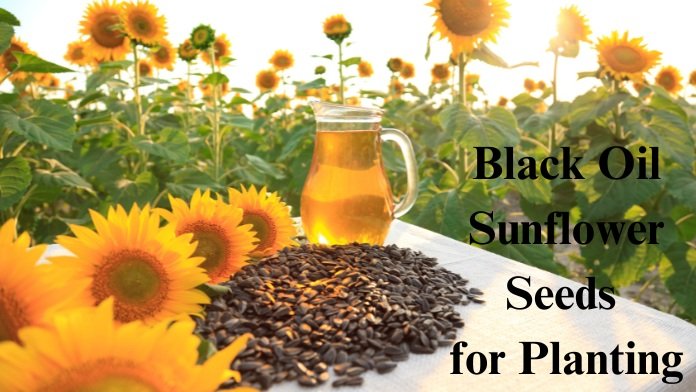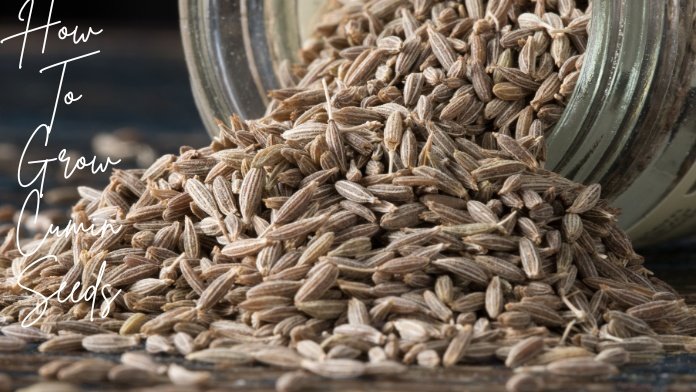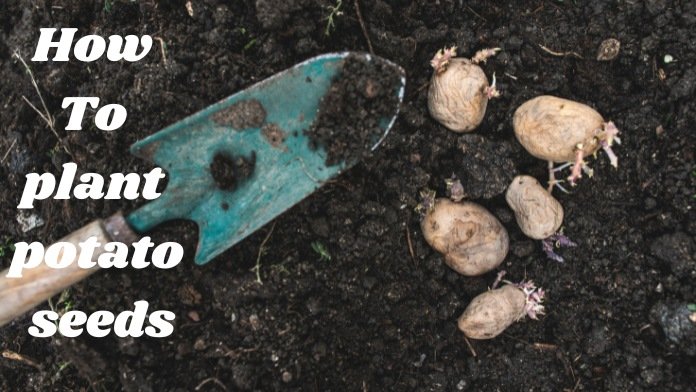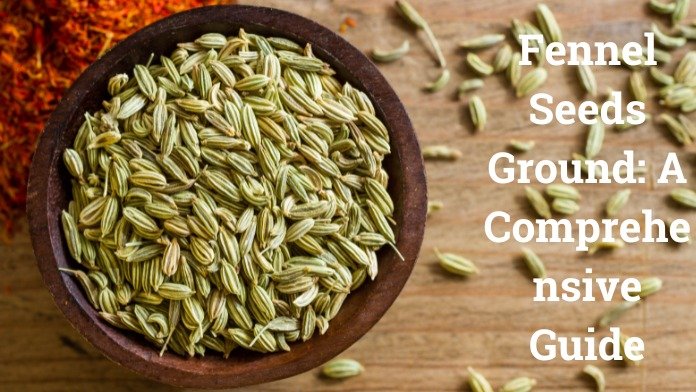
Black oil sunflower is an open-pollinated cultivar primarily used to produce sunflower seeds or oil. It can be very effective as a cover crop in warm seasons. Black oil sunflowers are 5 to 7 feet tall and easy to grow on any scale, whether a raised bed or a few acres.
When grown as a cover crop, sunflowers act as soil cleaners and help remove impurities. Their intense root system allows them to cycle and remove nutrients from the depths. They are relatively drought-tolerant and do well in the heat of summer when rainfall can be low.
This guide discusses everything you need to know about black oil sunflower seeds for planting. It explains all the supplies you need, teaches you how to prepare for planting, gives you step-by-step planting instructions, describes how to care for your new seedlings, and helps you solve everyday problems.
What are Black Oil Sunflower Seeds?
Compared to regular striped sunflower seeds, black oil sunflower seeds have more prominent, denser seeds, higher oil content and better overall nutrition. Black oil sunflower seeds are rich in protein, fibre, calcium, vitamin B complex, planting and iron.
Black oil sunflower seeds come from a cultivar (or modified version) of the Helianthus annuus sunflower plant. They are an annual crop mainly used to make cooking oil and feed wild birds.
What is the Difference Between Sunflower Seeds and Black oil Sunflower Seeds?
Black oilseeds (“oilers”) have fragile shells, which are easy to open for almost all seed-eating birds, and the kernels they contain have a high-fat content, which most wintering birds highly prize. Striped sunflower seeds have a thick shell, which makes it much harder for sparrows and blackbirds to crack open.
When to Start Sunflower Seeds
Plant sunflowers in late spring after all threats of late frost have passed. If you can check the soil temperature, germination occurs in most sunflowers when soil temperatures are between 70 and 85 degrees Fahrenheit, so when the temperature reaches 60 to 65 degrees Fahrenheit.
Time to Sow Seeds Indoors
If you want to sow seeds indoors and transplant them outside, start them about four weeks before your area’s last spring frost date.
Presoaking Seeds Before Planting
- Soak the seeds before planting.
- Soaking seeds before planting is a common way to improve germination. Seeds naturally have a tough outer layer to protect them from insects, disease and adverse germination conditions. Soaking them in water softens the hard seed coat, exposing the embryo to moisture and allowing it to grow.
Direct Sowing Seeds Outdoors
Preparing the Soil
Sunflowers tolerate many soils and seem to grow and germinate almost anywhere. When growing them in your garden, you can plant the seeds with little prep work, but they will do better if you work the soil before planting them.
Cover the planting area with several inches of finished compost or aged manure. Work it into the soil using a shovel, garden rake or tiller, loosening the top 12 to 18 inches of soil. Friable soil without hard compaction allows the long tap roots of sunflowers to increase and improves water infiltration.
Seed Spot
Spacing depends on the type of sunflower you are growing and their approximate mature height. Taller plants need more space between seeds, but you can plant smaller varieties together.
You can plant the seeds close together and thin them at desired intervals if the seedlings have two or three pairs of leaves.
- Space giant sunflowers are 2.5 to 3 feet away.
- Space full-size sunflowers 1.5 to 2 feet apart.
- Space miniature sunflowers 6 to 12 inches apart.
Starting Sunflower Seeds Indoors
SUPPLIES NEEDED
Growing Medium: Coconut coir and commercial potting soil are two common growing mediums used in containers. Both are available online or at local retail stores. A quality growing layer in your container is essential; it holds moisture and nutrients, provides air space around the roots, and anchors the plant’s roots to keep them upright.
Containers: Seed starting trays are most accessible, especially with domes or covers. The vast and shallow trays allow you to plant many seeds in one tray. You can use separate containers for your seeds or recycle plastic containers from your kitchen (clean yoghurt cups, sour cream containers, etc.). Just make sure they are clean and sterile.
Plant Labels: Use plastic or wooden plant labels to label which seeds you planted and where. Plastic plant labels are more durable, and words don’t fade quickly. Wooden labels are biodegradable and more environmentally friendly.
Supplemental Grow Lights (Highly Recommended): LED, fluorescent, and compact fluorescent grow lights are good options for hobby growers. Grow lights emit different wavelengths or “colours” of light crucial to plant growth.
Seed Starting Mat (highly recommended): A seed starting mat speeds up germination. It is similar in size and shape to a household heating pad and is placed under a seed starting tray to warm the substrate.
How to Plant Black Oil Sunflower Seeds

Plant seeds 1 to 2 inches deep and 8 to 12 inches apart in loose soil and full sun. For best results, plant sunflower seeds when the spring is warm, and all danger of frost has passed.
Staggered planting over several weeks allows plants to mature at different times and ensures a continuous supply of ready-to-eat birdseed. Sunflowers can be grown in all soil types, including deep pots, and require no supplemental fertilization.
Excessive fertilization can reduce seed yield by spoiling seedlings. Water the seeds daily (twice daily in hot or dry weather) until the seedlings are well established, then water thoroughly every other day.
Planting
- Plant depth: 1 – 2″
- Minimum germination temperature:39°F
- Seeding rate:8 – 12 lb/acre
- Outdoor seed rates:15 – 25 lb/acre
Step-by-Step Planting Instructions
- Fill containers almost to the top with a pre-moistened growing medium.
- Plant seeds about 1 inch deep and then cover with mulch.
- Mist soil pot with room temperature water.
- Cover the pot with a lid or plastic bag to increase humidity.
- Place the containers on a planting mat or somewhere slightly warmer than the air temperature in your home, such as on top of the refrigerator.
- Sprinkle the potting soil periodically to moisten the medium without disturbing the seeds.
- If condensation builds up inside the lid or bag, remove it for a while or leave it open to allow air to circulate.
- Once the seeds have sprouted and germinated, remove the lid so they don’t get damp and move the pots to a bright spot.
Steps for Harvesting Sunflower Seeds
- When they dry, cover the heads you want to save with fine mesh, such as mosquito netting or a stapled paper bag, to keep them from flying away.
- Or cut flower heads and bring them inside to dry. You know they are dry because the seeds will be easier to separate from the heads.
- Alternatively, you can save the heads with intact seeds.
- Store seeds in a cool, dry place to prevent mould or rot.
- If you can, leave the stalks standing during the winter for the roosters to graze on. If they have to go outside, compost them.
Transplanting Seedlings Outdoors
When transplanting your sunflowers outdoors, disturb or manipulate the root system as little as possible. Dig holes with the following recommended spacing. The holes should be about twice as deep as the containers and 1.5 times as broad.
- Space giant sunflowers 2.5 to 3 feet apart.
- Space full-size sunflowers 1.5 to 2 feet apart.
- Space miniature sunflowers 6 to 12 inches apart.
Care Of Your Sunflower Seedlings
Sunlight
When grown outdoors, sunflowers need a full sun location that receives at least six to eight hours of sunlight daily.
Indoors, seedlings need a location that receives twelve to sixteen hours of bright sunlight. The best spots are near south- or west-facing windows.
Temperature Requirements
Sunflowers thrive in warm conditions, need many warm days to grow, and have large, beautiful heads.When planting outdoors, consider local spring conditions.
Wait until the threat of frost has passed. If your region is prone to cool, rainy spring weather, wait until the rain subsides before planting. If starting seeds indoors, keep the ambient air temperature between 70 and 78°F.
Watering Needs
Once the seedlings have sprouted, moisten the soil or growing medium without overwatering.
- You can reduce watering about six to eight weeks after germination (after transplanting indoor seedlings outside). Instead of keeping the soil slightly moist, allow it to dry out and give the plants about an inch of water once or twice a week.
- For outdoor seedlings, water them lightly every 2 to 3 days, thoroughly soaking the soil 3 to 4 inches around the plants. Avoid spraying plants directly with the hose stream and dislodging them from the ground.
- Place the containers in a shallow water container for indoor seedlings so they absorb the water they need. Bottom watering helps prevent overwatering and will not dislodge seeds or seedlings like overhead watering.
Solving Ccommon Problems With Sunflower Seedlings
Damping Off
Dampness is a problem caused by fungi or mould that thrive in cold, damp conditions, causing seedling death.
Leg Plants
When seedlings grow tall and thin, it is a sign that they are not getting enough light.
There’s only so much you can do to help plants grown outdoors change their light exposure other than ensure nothing shades them during the day.
If sowing seeds indoors, try moving the plants to a location that receives more sun or supplementing the lighting with a grow light.
Discoloured Leaves
Since the seed contains only a tiny amount of food, young plants become discoloured when these reserves are depleted. Lack of phosphorus causes the leaves to take on a reddish-purple hue.
Yellow leaves may indicate that the seedlings need nitrogen. To fix discoloured leaves, apply half a dose of diluted plant food.
PESTS
Garden-grown sunflowers have far fewer insect pest problems than many other garden plants. But keep an eye out for beetles, weevils, and earwigs, significantly as the heads develop.
Indoor plants have fewer pest problems than outdoor plants, but fungus gnats are problematic.
How To Preserve and Handle Black Oil Sunflower Seeds
- Always store birdseed outside your home in a cool, dry place.
- Store birdseed in rodent- and insect-proof containers.
- Do not mix old seeds with new ones.
- During warm weather, save only as much seed as your bird can eat in two weeks.
- In cold winter climates, extend that storage to four weeks.
- Keep a day or two’s supply of seeds in your feeder so they are devoured and stay fresh.
- Discard mouldy, rotten or foul-smelling seeds, which can harm the bird’s health.
FAQ
Are Black Oil Sunflower Seeds Suitable for Planting?
You can plant the black oilseeds you get in your birdseed. I read that sunflowers grow 3 to 6 feet tall. So this year, I will add them to the sunflowers I grow as a treat for wild birds.
Are Black Oil Sunflower Seeds Organic?
Sunflower seeds are 100% organic, with no fillers or pesticides. This mixture can be used in any garden bird feeder. Our team of bird lovers mixes packages, inspects, and numbers each lot by hand in New York’s Hudson Valley.
Which Sunflowers Produce Black Oil Sunflower Seeds?
Black oil sunflower seeds come from a cultivar (or modified version) of the Helianthus annuus sunflower plant. They are an annual crop mainly used to make cooking oil and feed wild birds.
How Long Does Black Oil Sunflower Take to Mature?
Black oil sunflowers mature in about 100 to 120 days so that a mid-April planting date will provide mature seeds in mid-August.
How Many Pounds of Black Oil Sunflower Seeds Per Acre?
Expect to apply about 20 pounds per acre.
Does the Black Oil Sunflower Come Back Every Year?
They are an annual crop, mainly used to make cooking oil and feed wild birds.
RELATED POSTS
View all


